A mixed diagnosis
Editor's note: John Thomas is managing director of Burke Healthcare, a division of research company Burke, Inc. Gabriela Pashturro is senior vice president at Burke, Inc. Catherine Salzman is director of social insights and analytics at Seed Strategy, a growth acceleration firm.
Over the past several months, many of life’s tasks have shifted to online. From work to school to shopping, people have turned to virtual options to keep life moving while also staying safe. Across industries, companies have leveraged virtual options to maintain business – and the health care industry is no exception.
While telehealth visits have been around for a long time, the significant increase in usage – driven by the pandemic – makes them feel like an innovation, especially to patients. With this surge of new users, we conducted an online survey of telehealth users – 431 patients and 228 providers – to explore the experiences and behaviors associated with telehealth visits during the pandemic. (In order to participate in the study, patients and providers had to have utilized telehealth for at least one visit during the pandemic.) Here’s a look at our findings.
Utilization and experience
It’s no surprise that providers had more experience with telehealth leading into the pandemic and see more potential in leveraging telehealth during and post-pandemic as compared to consumers (Figure 1). Overall, our data shows that patients are very satisfied with their telehealth visits, with nearly half of patient respondents (47%) reporting being very satisfied. However, provider respondents are much less satisfied, with only 12% reporting that they are very satisfied with the telehealth experience.
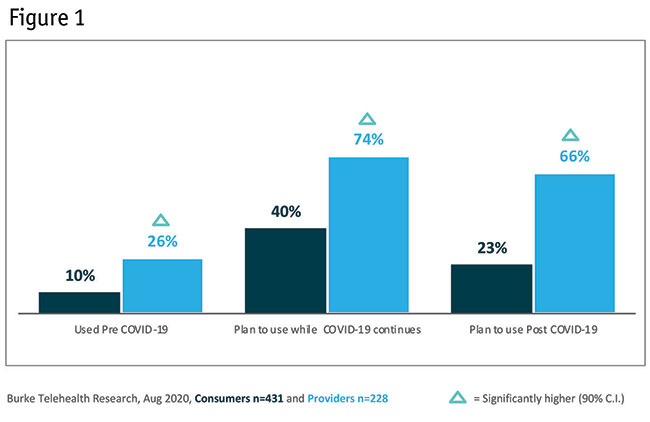 Both patients and providers appreciate the efficiency of telehealth and rate experiences – such as the ease of scheduling, wait time and overall time spent for the appointment – very high (Figure 2). As one patient said, “I like it, I was seen quickly and she answered everything well, I thought, and I could get back to work and not spend hours at a doctor’s office.” Both groups also feel positive about the privacy and security of the information shared.
Both patients and providers appreciate the efficiency of telehealth and rate experiences – such as the ease of scheduling, wait time and overall time spent for the appointment – very high (Figure 2). As one patient said, “I like it, I was seen quickly and she answered everything well, I thought, and I could get back to work and not spend hours at a doctor’s office.” Both groups also feel positive about the privacy and security of the information shared. 
However, there is clearly a disconnect. How can nearly half of patients be very satisfied with their experience, while only 12% of providers feel the same way? Perhaps it is in the eye of the beholder. For example, Figure 3 shows that while patients feel they can effectively communicate and receive a high quality of care during a telehealth visit, providers are much less likely to feel the same way. Additionally, technology and log-in complications further exacerbate the issue for providers when it comes to embracing telehealth. One provider said, “I have had so many problems with the technology that wastes time and interferes with patient care.” These non-clinical care experiences were rated as one of the most negative factors among providers.
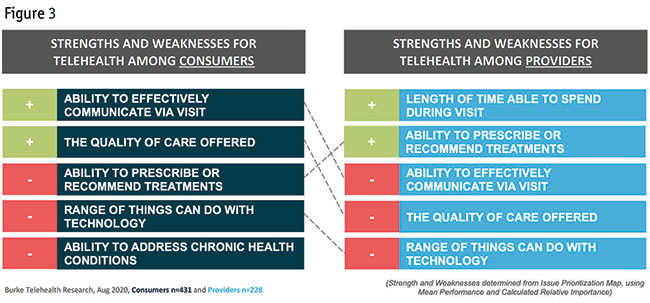
Advantages and disadvantages
If both patients and providers will be navigating a mix of in-person and telehealth visits moving forward, it is worth investigating the advantages and disadvantages to uncover why an individual might choose one option over the other. When asked to report on the advantages and disadvantages, patients and providers agree that telehealth visits are more efficient. Interestingly, while the comfort of sharing issues from home was seen as an advantage for both groups, patients were significantly more likely to report this as an advantage of telehealth compared to providers.
As for the disadvantages, agreement was found among both groups. While the top disadvantages are the same for both patients and providers, providers report issues with technology at significantly higher rates than patients. Providers also view diagnostics as a bigger disadvantage than patients, with over 50% stating it as a disadvantage compared to only 39% of patients (Figure 4).
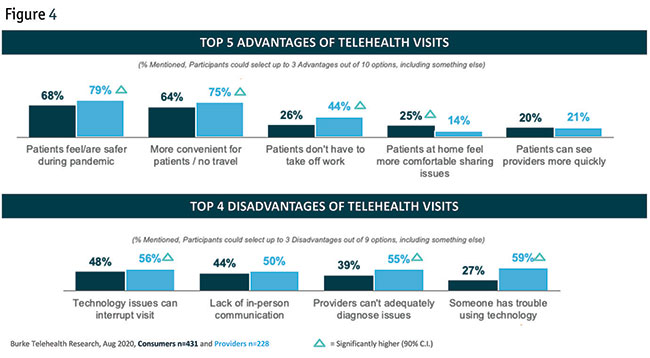
A surprising disconnect in the findings centered on quality. While two-thirds of patients feel that telehealth addresses issues with the same quality as in-person visits, only 36% of providers feel the same (Figure 5).
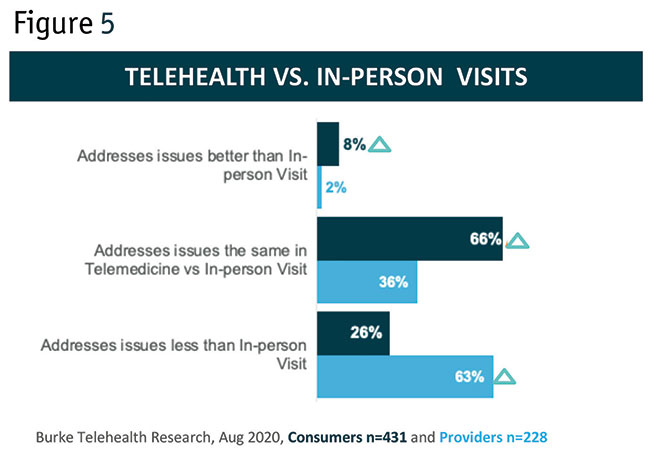
Open to switching
While a majority of patients state they enjoy the convenience of telehealth visits, view the quality of telehealth the same as in-person and plan to leverage the service for at least some of their appointments in the future, we wondered if people would be willing to switch doctors or health plans to maintain this option moving forward. While in the minority, a notable 11% would be willing to switch doctors and almost 20% would be willing to switch insurance plans to maintain this option.
Providers, while less enthusiastic across a number of metrics, also recognize the value of the service to their practice, especially when it comes to growth and efficiency (26% agreed that telehealth services allow them to grow their practices and 39% agreed that it has improved efficiency).
Cost and quality questions linger
In addition, reimbursement for telehealth visits is an ongoing point of contention with providers, with many providers believing that telehealth visits should be reimbursed at the same rate as in-person visits, while a majority of patients feel that telehealth visits should be offered at a lower cost. Finally, there is a clear disconnect around quality of care. While 68% of providers believe telehealth will never equal the quality of care received during an in-person visit, a significantly lower percentage of patients feel the same way.
The interesting case for behavioral health
The results were segmented by those patients who received, and those providers who provided, behavioral health services during this past year. The results indicate that a significantly higher proportion of behavioral health providers (51%) were already utilizing telehealth for their patient visits compared to providers overall (26%). Behavioral health providers also reported a significantly higher share of all their visits pre-, during and post-pandemic being via telehealth, compared to providers overall (Figure 6). Additionally, 71% of behavioral health providers believe telehealth visits address patient issues just as well, or better than, in-person visits. 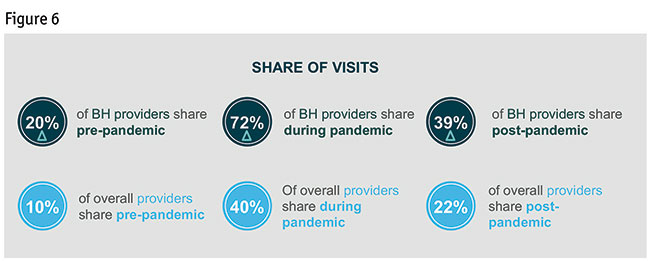
The future
While both patients and providers have embraced virtual services during the pandemic, early results indicate that patients appreciate this health care option more than those providing the care. This research helps uncover where the disconnects lie and sets the stage for improvements to help close the experience gap between patients and providers.
If we look closer at post-pandemic adoption, it may not be an either/or for respondents but rather a mix of medical visit options moving forward. Both patients and providers foresee the staying power of telehealth and believe there will be more telehealth visits than pre-pandemic (Figure 7). Patients anticipate about half of their visits to be serviced via telehealth in the future – similar to pandemic rates. Providers expect to reduce their share of telehealth visits from 40% of all visits during the pandemic to 22% post-pandemic.

While many were forced to try telehealth during the pandemic, most patients and providers will continue to opt for this choice post-pandemic. However, not all telehealth visits are created equal. As patients and providers begin to weigh their options, our research indicates that visits requiring a physical exam or diagnostics will remain largely in-person. Also, those who have had trouble with the technological aspects of telehealth – this includes both patients and providers – will likely revert to in-person visits. However, when efficiency is key, or for those more comfortable sharing sensitive information from the comfort of their home, telehealth may open the door for people to have more regular touchpoints with providers.
Finally, telehealth is allowing providers to meet with a greater number of patients and grow their practices without exhausting resources. While they may express a greater amount of frustration, the benefit to the bottom line will likely help keep telehealth an attractive option for providers moving forward.
Implications
To close, let’s take a look at the implications for providers and for patients.
Utilization must be modeled closely. Telehealth was primed to support both patients and providers during COVID-19 and created an influx of new consumers and providers utilizing this approach but where will it land post-pandemic? While these next chapters have yet to be written, we can be sure subsequent reimbursement decisions will surely drive future utilization.
Providers are clearly less satisfied with telehealth than consumers. For those tasked with managing components of telehealth for providers in organizations, focus on making technology an enabler instead of a distraction. Here, one size does not fit all, and determining quickly which niches of patients are best suited for telehealth will help ease some of the challenges, as will giving providers multiple telehealth models for various visit types.
Focus on the benefits of privacy and safety. Interestingly, patients and providers did not rate data safety and privacy as significant concerns when utilizing telehealth. However, given the general focus on consumer data privacy across industries, a lack of a worry here could be a true advantage – if managed properly. Privacy and safety are clearly seen as major advantages of telehealth visits, which can allow companies to further position telehealth utilization as part of the new normal.
Prepare to address potential switching behaviors. While the numbers of individuals who would switch doctors or health plans to keep telehealth visits as a future option is currently low (11%), once this option is unavailable, opinions may change. Consumers may be more inclined to seek out a new provider and/or plan to have continued access to the benefit of telehealth.
Behavioral health is one area primed for telehealth growth. With nearly 71% of behavioral health providers believing that telehealth visits address patient concerns as well as or even better than in-person visits, there clearly is an opportunity for growth.
